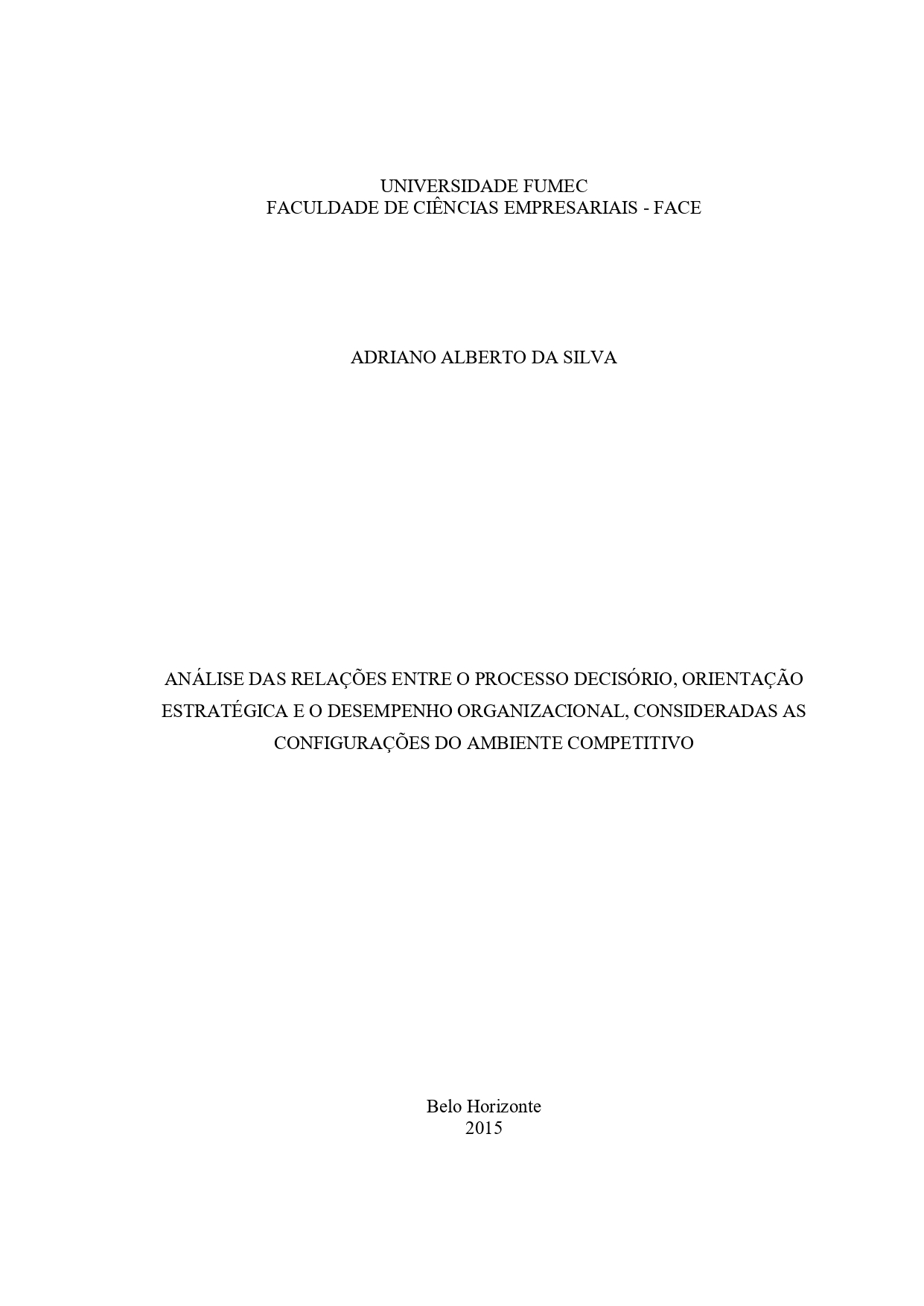Análise das relações entre o processo decisório, orientação estratégica e o desempenho organizacional, consideradas as configurações do ambiente competitivo

Visualizar/
Data
2015Autor
Silva, Adriano Alberto da
xmlui.mirage2.itemSummaryView.MetaData
Mostrar registro completoResumo
A imprevisibilidade e a complexidade dos fatores determinantes do desempenho têm exigido
das organizações uma maior capacidade de tomar decisões e traçar estratégias que possibilitem
superar os crescentes desafios. Este estudo, aplicado a cooperativas médicas do Sistema
Unimed, tem como objetivo analisar a relação e a intensidade da interação entre a orientação
estratégica, o processo decisório e o desempenho organizacional, consideradas as configurações
do ambiente competitivo. O referencial teórico trata dos constructos abordados nas análises
entre as relações propostas neste estudo e é embasado pelas literaturas clássicas e atuais
disponíveis. Neste trabalho também são abordados os fundamentos teóricos dos modelos
propostos por Venkatraman (1989), o STROBE - Strategic Orientation of Business Enterprises,
em que o autor abordou as relações entre os constructos da orientação estratégica e desempenho
e o de Tan e Litshert (1994), que ampliaram, refinaram e incluíram no modelo STROBE o
constructo ambiente competitivo, que serviu como modelo base deste estudo. A pesquisa
apresenta os dados coletados junto a 82 gestores de cooperativas médicas, com a aplicação de
questionário (survey). Para compreender as relações entre orientação estratégica, processo
decisório, desempenho organizacional e ambiente competitivo, propôs-se um modelo estrutural
em que as relações entre constructos são as expressões das hipóteses de pesquisa. Como
metodologia de mensuração e análise das relações entre os constructos, adotou-se a modelagem
de equações estruturais por meio da estimação de parâmetros pelo método PLS (Partial Least
Squares). O trabalho identificou como resultados o fato de o ambiente competitivo ter relações
de intensidade positiva com o processo decisório e a orientação estratégica. Foi encontrada
também uma relação positiva entre a orientação estratégica e o processo decisório. Sobre o
desempenho, constatou-se que nem o ambiente competitivo nem a orientação estratégica o
influenciaram, situação diferente daquela quando se compara a relação do desempenho com o
processo decisório, que apresentou uma relação negativa, ou seja, quanto menos abrangente o
processo decisório, melhor o desempenho. Caso similar aconteceu com a relação do
desempenho com a variável de controle porte da cooperativa médica, em que também foi
encontrada uma relação negativa, que significa que quanto menor o porte das organizações,
melhor o desempenho. The unpredictability and complexity of performance determinant factors have been demanding
from the organizations a greater decision-making and strategizing capacity which may enable
the overcoming of increasing challenges. This study, applied to medical cooperatives of the
Unimed system, aims to analyze the connection as well as the interaction intensity among
strategic orientation, the decision-making process and the organizational development,
regarded as the competitive environment configurations. The theoretical references deal with
the constructs mentioned in the analysis among the connections proposed in this study and is
based on both classical and updated available literature. This project also deals with the
theoretical fundamentals from the models proposed by Venkatraman (1989), the STROBE -
Strategic Orientation of Business Enterprises, in which the author approached the connections
between the constructs of strategic orientation and performance in addition to the one proposed
by Tan and Litshert (1994), who widened, refined and included the competitive environment
construct in the STROBE model, which was used as a base model to this study. The research
presents data collected from 82 managers of medical cooperatives through the use of a survey.
In order to make the connections among strategic orientation, decision-making process,
organizational performance and competitive environment understood, a structural model in
which the connections between the constructs are the hypothesis expressions of the reascend
was proposed. As a measuring methodology and construct relationship analysis, structural
equation modeling by the parameter estimate through the PLS method (Partial Least Squares)
was adopted. The identified result was the fact that the competitive environment is positively
related to both the decision-making process and the strategic orientation. A positive connection
between the strategic orientation and the decision-making process was also found. It was
noticed that neither the competitive environment nor the strategic orientation influenced
performance. A situation which was different from when comparing performance to the
decision-making process. It then presented a negative connection, which means that the least
comprising the decision-making process, the best the performance. A similar result was noticed
when checking the connection between performance and the size control variable of the medical
cooperative. A negative connection was found there as well, which means that the smaller the
organization, the best the performance
